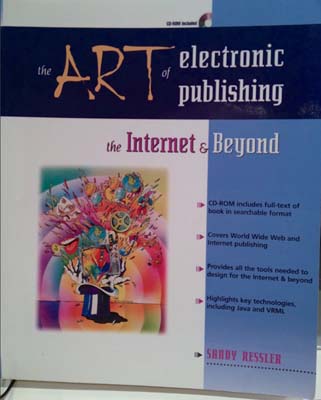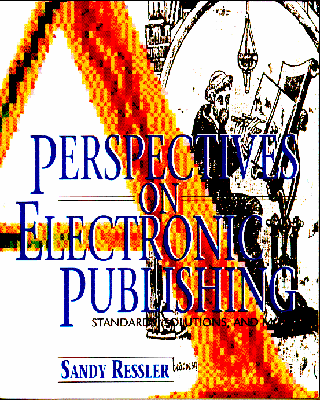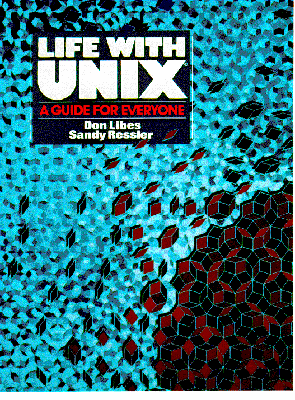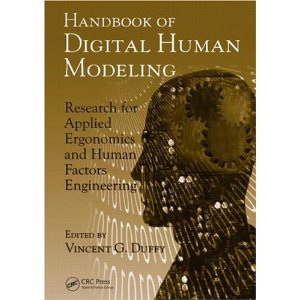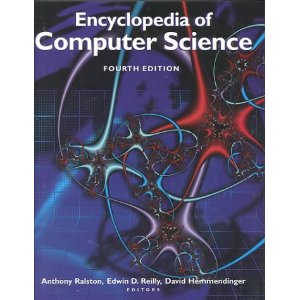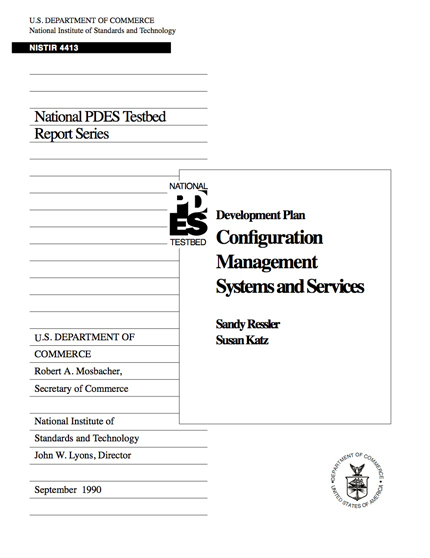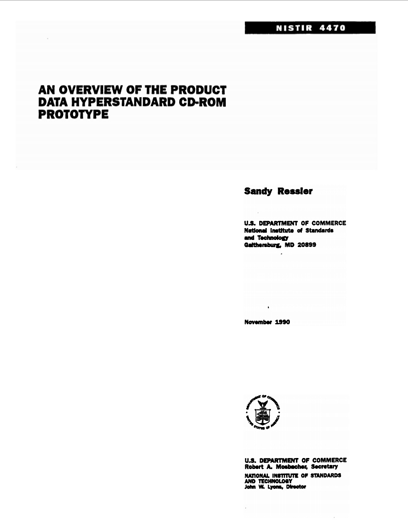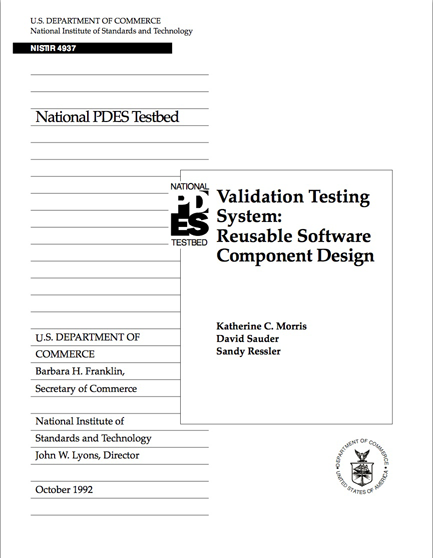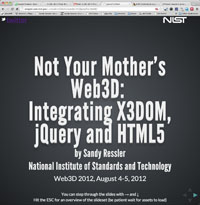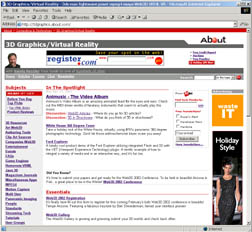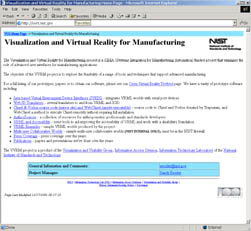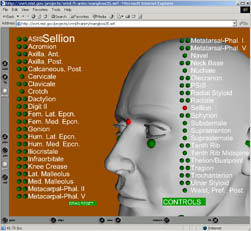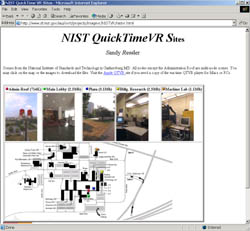Education
1978-1980 Master of Fine Arts Rutgers University, Mason Gross School of the Arts.
1974-1978 Bachelor of Arts, in Visual Arts (visual art) Rutgers University, Rutgers College, with departmental honors.
Affiliations
March 85 - Present
National Institute of Standards and Technology:
Researcher: From Oct 2010 to present. Investigating the application and theory of Information Visualization and 3D on the web technologies (WebGL/X3DOM) for a variety of scientific applications, within the High Performance Computing and Visualization Group of the Mathematics and Applied Computation Division.
Program Manager: From Oct 2006 to Oct 2010, Complex Systems program responsible for a portfolio of projects totally approximatly $2.5M/year. Developed vision plans and oversee execution of projects dealing with complex systems. Complex systems are those types of systems in which large numbers of similar entities exhibit some type of macroscopic behavior that can not be predicted simply by looking at the individual entities. Application domains are currently primarily Networking oriented, future applications will involve biological systems, nanotechnology, complex engineering as opportunities arise.
Project Supervisor: Visualization and Virtual Reality (VVR) project obtaining funding between $500-750K/year for over 10 years. Responsible for planning, management of a staff of 3-5, and most of the technical design work of the project. Created the Open Virtual Reality Testbed. I created the testbed, obtained funding and have received a fair amount of publicity due to a collection world wide web pages I maintain. I was also a principle technical staff member in the initiation and development of a NIST wide "Virtual Library" project which seeks to bring the information resources of the NIST library to staff members desks. Also active in a variety of manufacturing standards efforts. I have also been active in obtaining several cooperative research agreements between outside industry and NIST. Participant in a number of other projects including: A graphical tool to generate 2D tilings for research sponsored by the Bureau of Engraving and Printing; Visual display of control systems; Implementation of a shape grammar for stylistic analysis of an artist; Development of object oriented data base systems for use in data representation; and Systems programmer for a sizable network of Sun's, and Silicon Graphics Iris's.
November 99 - 2006
Web3D Consortium: Vice President (99-01) and Member of Board of Directors (99-06), active in the H-ANIM (Humanoid Animation) working group and founded the Medical Working Group, leading successful effort to obtain grant funding for the consortium.
October 97 - June 2002
About.com: 3D Graphics/Virtual Reality Guide running what was, during its existance,
the most popular web site (Article Archives)
for information about VRML and other 3D Web technologies. From October 1997 to June 2002
I wrote a weekly feature article (194 total) for the site, and provided
links to hundreds of information sources, tutorials, and examples. In addition
to writing I hosted weekly chats sometimes with noted guests. The site was
internationally recognized and was generally considered a "must see" web site
for obtaining the latest news and information on the Web3D field.
October 84 - March 85
Navigation Sciences: Responsible for the specification, procurement,
and installation of a VAX 730 based software development system. This included
budgeting and justification of the system. An Ethernet was installed between
several IBM PC's and the VAX which was running UNIX 4.2. Software was to be
developed on the PC's with support data bases and other tools on the VAX. Additionally
graphics software for the PC's was reviewed and selected for the development
of a PC bases navigation system with integrated nautical charts.
December 82 - October 84
Videomagic Laboratories: Part of a software group that designed and implemented a real time surrogate travel system using video disks, overlay graphics, audio with digitized speech and digital data from the video disk. The project was for a video disk based arcade game. All the work was done in C on 68000 based development systems and later downloaded to a 68000 S100 based run time system. Responsibility in the integrated system included: designing and implementing real time graphics code and a data base system which was a mechanism for describing animations. Also served as the "unofficial" systems person responsible for the maintenance of 5 UNIX machines. Supervised part-time personnel and consultants who worked on systems tasks. Responsible for producing a prototype film which functioned as a testbed for the surrogate travel software, including budgeting and hiring outside production staff.
June 82 - December 82
Carnegie Mellon University: Designed and implemented (Pascal) an interactive graphics system which allowed teachers to produce illustrations and animations using an IBM PC. The system was a combination of a paint system with animation capabilities. This software later became part of a start-up company delivering educational and training systems.
June 80 - June 82
Bell Laboratories: Associate Member of Technical Staff. Worked on software (C and UNIX) for a real time 3D graphics processor. Primary accomplishments were to write example programs which demonstrated the potential application of the animation processor. This included: an interactive object editor for the creation and manipulation of 3D objects; a dancing figure and robot arm with interactive controls; animations of matrix multiplication and sign language illustrated educational potential. Also worked on an interactive video disk project where I interfaced a touch screen and wrote the software for doing hit-detection on video objects. This was the prototype for a system deployed in Disney's EPCOT Center. Summary Video
Peer Reviewed Papers
- Kevin Mills, Christopher Dabrowski, James Filliben, Sandy Ressler, "Combining Genetic Algorithms & Simulation to Search for Failure Scenarios in System Models" to appear in Proceedings of the Fifth International Conference on Advances in System Simulation, Oct 27, 2013 - Nov. 1, 2013, Venice, Italy
- Sandy Ressler, Kyle Leber, "Web Based 3D Visualization and Interaction for Whole Body Laser Scans" in Proceedings of the 4th International Conference on 3D Body Scanning Technologies, Long Beach CA, USA, Nov. 19-20, 2013.
-
 Declarative integration of interactive 3D graphics into the world-wide web: principles, current approaches, and research agendaJacek Jankowski, Sandy Ressler, Kristian Sons, Yvonne Jung, Johannes Behr, Philipp Slusallek
Declarative integration of interactive 3D graphics into the world-wide web: principles, current approaches, and research agendaJacek Jankowski, Sandy Ressler, Kristian Sons, Yvonne Jung, Johannes Behr, Philipp Slusallek
Web3D '13 Proceedings of the 18th International Conference on 3D Web Technology, 2013 - Sandy Ressler Web-based Declarative 3D Graphics for Anthropometry Visualization and Education" in Proceedings of the The Graphical Web 2012, Zurich, Switzerland, Sept. 11-14, 2012.
- Sandy Ressler Slides, Filters and Mobile Oh My! in Proceedings of the 1st International Workshop on Declarative 3D for the Web Architecture (DecD2012 at WWW2012), Lyon, France, April 17, 2012. (short paper)
- Qiming Wang, Bonita Saunders, Sandy Ressler Dissemination of 3D Visualizations of Complex Function Data for the NIST Digital Library of Mathematical Functions in Data Science Journal, Vol. 6 (2007).
-
 Generation and manipulation of H-Anim CAESAR scan bodiesQiming Wang, Sandy Ressler
Generation and manipulation of H-Anim CAESAR scan bodiesQiming Wang, Sandy Ressler
Web3D '07 Proceedings of the twelfth international conference on 3D web technology, 2007 - Afzal Godil, Sandy Resler, Retrieval and Clustering from a 3D Human Database Based on Body and Head Shape in Proceedings of 2006 Digital Human Modeling for Design and Engineering, July 2006, Lyon France.
- R. Mollard, S. Ressler, K. Robinette Database contents, structure, and ontology for WEAR in proceedings of IEA2006: 16th World Congress on Ergonomics, July 10-14, 2006, Maastricht, The Netherlands.
- Qiming Wang, Sandy Ressler A Tool Kit to Generate 3D Animated CAESAR Bodies in proceedings of Digital Human Modeling for Design and Engineering (DHM), June 14-16, 2005, Iowa City, Iowa.
- Afzal, Godil, Sandy Ressler and Patrick Grother, Face Recognition using 3D surface and color map information: Comparison and Combination in the SPIEs symposium on Biometrics Technology for Human Identification, April 12-13, 2004, Orlando, FL
- Afzal Godil, Patrick Grother, Sandy Ressler Human Identification from Body Shape in 4th International Conference on 3D Digital Imaging and Modeling, Oct 6-10 2003, Banff, Canada.
- Sandy Ressler, Qiming Wang Using Web3D Technologies to Visualize and Analyze Caesar Datain proceeding of XVth Triennial Congress International Ergonomics Association (IEA 2003) Aug 24-29, Seoul, Korea.
- Sandy Ressler, Qiming Wang A Web3D Based CAESAR Viewer in Proceedings of Computer Assisted Radiology and Surgery (CARS) 2002 - H.U. Lemke, M.W. Vannier; K. Inamura, A.G. Farman, K. Doi & J.H.C. Reiber (Editors) CARS/Springer.
- Sandy Ressler, A Web-based 3D Glossary for Anthropometric Landmarks in Proceedings of HCI International 2001, New Orleans, LA, August 5-10, 2001. video
-
(video)
 Integrating active tangible devices with a synthetic environment for collaborative engineeringSandy Ressler, Brian Antonishek, Qiming Wang, Afzal Godil
Integrating active tangible devices with a synthetic environment for collaborative engineeringSandy Ressler, Brian Antonishek, Qiming Wang, Afzal Godil
Web3D '01 Proceedings of the sixth international conference on 3D Web technology, 2001 - Sandy Ressler, Brian Antonishek, Qiming Wang, Afzal Godil, Keith Stouffer, When Worlds Collide - Interactions between the Virtual and the Real Proceedings on 15th Twente Workshop on Language Technology; Interactions in Virtual Worlds, Enschede, The Netherlands, May 19-21, 1999.
-
(video)
 A VRML integration methodology for manufacturing applicationsSandy Ressler, Afzal Godil, Qiming Wang, Gregory Seidman
A VRML integration methodology for manufacturing applicationsSandy Ressler, Afzal Godil, Qiming Wang, Gregory Seidman
VRML '99 Proceedings of the fourth symposium on Virtual reality modeling language, 1999 -
 Making VRML accessible for people with disabilitiesSandy Ressler, Qiming Wang
Making VRML accessible for people with disabilitiesSandy Ressler, Qiming Wang
Assets '98 Proceedings of the third international ACM conference on Assistive technologies, 1998 - Sandy Ressler, Qiming Wang "Integrating Factory Floor and Human Simulation in a Portable Web-Based Environment" in Proceedings of Human Factors and Ergonomics Society European Chapter 1997, Bochum Germany, Nov 6-8, 1997.
- Sandy Ressler, Bill Trefzger "Development of the NIST Virtual Library" IEEE Internet Computing Vol . 1, No. 5, Sept-Oct 97, pg 35-41.
-
 Using VRML to access manufacturing dataSandy Ressler, Qiming Wang, Scott Bodarky, Charles Sheppard, Gregory Seidman
Using VRML to access manufacturing dataSandy Ressler, Qiming Wang, Scott Bodarky, Charles Sheppard, Gregory Seidman
VRML '97 Proceedings of the second symposium on Virtual reality modeling language, 1997 - Approaches Using Virtual Environments with Mosaic (PDF) in Proceedings of Second International WWW Conference '94 Mosaic and the Web, October 1994. (video)
- "Experiences with Heterogeneous-Platform CD-ROM's," Proceedings of the Advanced Information Interfaces: Making Data Accessible Conference, June, 1991.
- J. Kirsch, Russell Kirsch and Sandy Ressler: "Computers Viewing Artists at Work (PDF)," Proceedings of Syntactic and Structural Pattern Recognition, March, 1987. (video) (original images:1 2)
-
 The incrementor: a graphical technique for manipulating parametersSanford Ressler
The incrementor: a graphical technique for manipulating parametersSanford Ressler
ACM Transactions on Graphics (TOG), 1987 - An Object Editor for a Real Time Animation Processor, Proceeding of Graphics Interface 82, Toronto Canada. (video)
Books
Chapters and Invited Papers
- Standards the Glue for Innovation, Sandy Ressler published in Standard Engineering, The Journal of SES - the Society for Standards Professions, Vol 71, No 2. March/April 2019; 2nd place winner Worlds Standards Day Paper Competition 2018
- Shape and Size Analysis and Standards, by Godil and Ressler, in Handbook of Digital Human Modeling, Duffy (editor), CRC press 2008, ISBN 0805856463
- Markup Languages, in Fourth Edition of the Encyclopedia of Computer Science Nature Publishing, Grove Reference, 2000 ISBN 0-333-77879-0
- Network Based Documents (PDF) chapter in OII Spectrum Management Handbook, Technology Appraisals, 1995.
- Towards Intelligent Document Processing - from batch to WYSIWYG and beyond, OII Spectrum Vol. 1, No. 5, Feb. 1994.
- Contributor to: Virtual Reality Assessment - A Report of the Task Group on Virtual Reality to the HPCCIT Subcommittee of the NSTC. April 1994.
- U.S. VR Policy Raises Concerns, Real Time Graphics, Vol 2, No. 3, Sept. 1993.
- Battele Seattle Group Paper on Graphic Input Interaction Techniques, Siggraph Computer Graphics 1983.
Magazines
- Intellectual Property Issues and the Web3D Consortium Standards Developement in ACM SIGGRAPH Public Policy May 2003 Computer Graphics Column
- Don't Crush That Polygon!, 3D Magazine, The Rebirth of Web3D, Special Issue Spring 2000
- Web3D Trends, Nikkei CG Magazine (Japan), #7, 2000 July. vol. 166
Lectures
- What's That 3D Model Doing in my Web BrowserModel-Based Enterprise Summit 2014, December 17, 2014
- Web-based Declarative 3D Graphics for Anthropometry Visualization and EducationThe Graphical Web 2012, September 11-14, 2012
- Not Your Mother's Web3D: Integrating X3DOM, jQuery and HTML5, Web3D 2012, August 4-5, 2012
- Organizer of Panel Use and Value of Open 3D Standards at Medicine Meets Virtual Reality 13, Jan 29, 2005, Long Beach, California.
- Beer Bellies, Bountiful Behinds and other Mysteries of the Human Form, Digital Human Modeling for Design and Engineering, Montreal Canada, June 18, 2003; Computer Animation and Synthetic Actors CASA 2003, Rutgers University, May 8, 2003; University of Michigan Center for Ergnomics graduate seminar Sept. 9, 2003
- 3D Computer Graphics on the World Wide Web, Surf Students Lecture, June 22, 2001 (video)
- State of the Art for 3D on the Web, DVExpo 2001, Los Angeles, CA, December 4, 2001.
- VRML a Standard for 3D on the Internet, SigCAT '98 Baltimore, MD, May 19, 1998.
- Where do we go
now?, Systems Anthropometry Workshop June 1997.
- If there are so many
standards, why can't my avatar dance with yours?, Virtual Humans 97, June
1997.
- Real World Virtual
Reality and Manufacturing, INFORMS Washington DC, Spring 96.
- Open Virtual
Reality Testbed Activities, NASA workshop on Human-Computer Interaction
and Virtual Environments Ahmed K. Noor (ed.), NASA Conference Publication 3320,
Nov. 1995.
- Approaches
Using Virtual Environments with Mosaic (PDF) at the WWW94 conference Oct.
94.
- Open
Systems and Virtual Reality: The Role of Standards in Creating a Market (PDF) at the VR93 Conference May 93.
- Open Systems and Virtual Reality (PDF) at the EFDPMA Virtual Reality Conference June 93.
- Applying Hypertext Technology to Standards Development, Dissemination and Implementation,
at Standards & the Desktop, GCA, Boston MA, Nov. 16-18, 1988.
3D Computer Graphics on the World Wide Web from sandyr on Vimeo.
NISTIR´s
- Sandy Ressler (editor), Complex Systems Collected Images of the Month March 2008 - June 2010 , NIST Special Publication 500-286, June 2010
- Sandy Ressler (editor), Complex Systems Program Activities Summary, Fiscal Year 2009 , NISTIR 7569, May 2010
- Sandy Ressler (editor), Complex Systems Program Activities Summary, Fiscal Years 2007-2008, NISTIR 7569, March 2009
- Qiming Wang and Sandy Ressler, Translating IGRIP Workcells into VRML2, NISTIR 6076, National Institute of Standards and Technology, Sept.,97.
- Applying Virtual Environments to Manufacturing (HTML) (PDF) NISTIR 5343, Jan.,94.
- KC Morris, David Sauder and Sandy Ressler: "Validation
Testing System Reusable Software Component Design," NISTIR 4937, National
Institute of Standards and Technology, Gaithersburg, MD, 1992.
- Sandy Ressler: "The
National PDES Testbed Mail Server User's Guide," NISTIR 4508, National
Institute of Standards and Technology, Gaithersburg, MD, 1991.
- Sandy Ressler: "An
Overview of the Product Data Hyperstandard CD-ROM Prototype," NISTIR
4470, National Institute of Standards and Technology, Gaithersburg, MD, 1990.
- Sandy Ressler and Susan Katz: "Development
Plan: Configuration Management Systems and Services," NISTIR 4413,
National Institute of Standards and Technology, Gaithersburg, MD, 1990.
- Sandy Ressler and Steve Clark: "VOILA:
A System for Looking at Processes," NISTIR 4196, National Institute
of Standards and Technology, Gaithersburg, MD, 1989. (video)
- Sandy Ressler: "Tile
Tool: A Graphical Interface for the Exploration of Generalized Penrose Tilings (PDF),"
NBSIR 3488, National Bureau of Standards, Gaithersburg, MD, 1989. (video)
- Sandy Ressler: "The
Hyperstandard: Applying Hypertext Technology to Standards Development, Dissemination
and Implementation," NISTIR 3859, National Institute of Standards and Technology,
Gaithersburg, MD, 1988.
- Y. T. Lee and Sandy Ressler: "Converting
the AMRF Part Model Report to a PDES/STEP Subset," NBSIR 3818, National
Bureau of Standards, Gaithersburg, MD, 1988.
- Sandy Ressler: "Using
the AMRF Part Model Report," NBS Internal Report 3531, National Bureau
of Standards, Gaithersburg, MD, 1987.
- Steve Clark and Sandy Ressler: "The
Geometry Modeling System User's Guide," NBS Internal Report 3508, National
Bureau of Standards, Gaithersburg, MD, 1986.
Bell Labs Technical Memorandum
- S.P. Ressler, Keymap: A Visual Technique of Keyboard to CRT Mapping, TM-81-11356-4, April 1, 1981
- S.P. Ressler, Sensitize: A Graphical Area Sensitization Facility, TM-81-11356-2, Jan. 28, 1981.
- S.P. Ressler, A Character Generation Facility for the TI Video Display Processor, TM-80-1356-6, Dec. 8, 1980
- S.P. Ressler, A Video Paint System for a Real Time Animation Processor, TM-80-1356-4, Nov. 3, 1980
- S.P. Ressler, An Object Editor for a Real Time Animation Processor, TM-81-11356-13, Oct. 1, 1980
CD-ROM´s
CD-ROMs used to be a big deal, the HyperStandard was the first CD-ROM produced at NIST for an interactive collection of documents. It ran on UNIX, Windows and Macs. CD-ROM for book contains the entire contents of the book.
- Product Data HyperStandard prototype, Nov. 1990.
- CD-ROM accompanying "The Art of Electronic Publishing" book, Prentice
Hall, Nov. 1996.
Bitcoin
Articles for Bitcoin Magazine (both web and in print) and blog "Bitcoin in Plain English"
- Bitcoin, Going Native, Oct 17, 2014
- Bitcoin 2014 Roundup, May 22, 2014
- What is a Bitcoin Address and How do You Sign It?, May 12, 2014; longer version in Bitcoin Magazine Print Issue #21, April 2014
- Bitcoin Micropayments, a New Enabling Technology, April 30, 2014
- I Sign, You Sign, We All Sign: Explanation of Multi-signature Transactions, April 2, 2014
- Verso Unboxing and Usage, March 24, 2014
- My Virgin Bitcoin Spending Experiences, March 21, 2014
- Explain Bitcoin Like I'm 50, Bitcoin Magazine Issue #22
- Lead of Bitcoin Foundation Education Committee effort for: "Bitcoin: A Technical Guide for Non-Technical Users" released July 2014
Courses
Independently developed course and multimedia (that was a hot term back then) interactive software document for a criminal justice application.
- Multimedia Development - A Hand's On Workshop 1993. A nationally offered course from the Technology Exchange Company of Addison-Wesley
- Maryland Proactive Community Supervision "Break The Cycle" CD-ROM and Web site, 2001. An interactive CD-ROM with integrated animations and video for training. Web site contains all the content except for videos. Produced for the Bureau of Government Research, University of Maryland, College Park.
Exhibitions
- "Twenty Years of Rutgers MFA's" at New Jersey State Museum of Art, April 82.
- Computer art film: Da Movies (video) and These Words Are the Data (video) at the Festival International de Jeune Cinema, in Hyeres France, June 80.
- These Words Are the Data (html5 video) at Voorhees Museum, Rutgers University MFA show, April 80.
Videos
- AnthroGloss X3DOM with jQuery (2012) - anthropometry education tool with 3D in web browser (no sound)
- Dancing CAESAR Poser (2007) - an experiment integrating full body laser scan data, mocap and animation software.
- The Animation Processor (1981) - summary of work on custom computer graphics hardware while at Bell Labs
- AT&T Archives: The UNIX Operating System (1981) - I produced the animations used in beginning to explain UNIX structure and dancing figures for end titles.
- Art Demo Reel 1975-1980 - animations produced while student at Rutgers and at Bell Labs.
- TIME Magazine, Oct 7, 2014: Walter Isaacson, "How Bitcoin Could Save Journalism and the Arts", I got quoted ;-)
- web3Dnews: Aug. 27, 2004: Sandy Ressler Recaps Demo or Die at SIGGRAPH(video excerpt)
- CRN, CMP Media: Dec 7, 2000 3-D Web for the Masses
- NYTimes: Oct 5, 2000 Three-Dimensional Space is the Next Frontier for the Internet
- GNN 1995: GNN Movie of the Week
- 1995: Meckler VR World
- Byte Magazine: April 1995 The Net's Next Big Thing: Virtual Reality
- Popular Mechanics: March 1995 Virtual Reality
- Not Your Mother's Web3D: Integrating X3DOM, jQuery and HTML5
A web based tutorial on integrating a variety of technologies for compelling user experiences. - Focus on Web3D - An About.com web site (link is to archive of articles)
Internationally recognized site on the current state of Web3D. Author of a weekly article about VRML and Web3D since Oct. 1997 totalling over 150 articles. - Open Virtual Reality Testbed
A leading government web site covering virtual reality and related NIST projects. - AnthroGloss, Anthropometric
Landmarks of the Body
An innovative 3D glossary for anthropometric names and their placement on the body using Web3D technology. - AnthroKids
A unique resource containing the only anthropometric measurements of children even surveyed in the United States, made available here for the first time. - QuickTime
VR of NIST Sites
A variety of NIST sites illustrated using QuickTime VR's image based photography. - ACM Distinguished Speaker from 2007 to present.
- Web3D 2013 Tutorial Chair: and showcase organizer moderator
- Web3D 2005 Symposium: cochair & showcase organizer moderator
- SIGGRAPH 2004: organizer and host of special session "Real Time 3DX: Demo or Die", (press article)
- Web3D Symposium 2004: program committee
- SIGGRAPH 2002, 2003, 2005, Web Graphics: jury member, course reviewer (03)
- SIGGRAPH 2003 Web3D Showcase organizer and moderator
- Web3D Symposium 2003 (Saint Malo, France): Web3D Showcase organizer and moderator; publicity chair
- Web3D Symposium 2002 (Tempe, Arizona): publicity chair; Web3D Showcase organizer
- VRML2000: program committee
- VRML99: program committee, peer reviewer - Program Committee and Paper Reviewer
- SGML/XML 97: peer reviewer
- SGML 96: peer reviewer
- ACM (Senior Member) - Association of Computing Machinery
- SIGGRAPH Computer Graphics Pioneers
Press
Fleeting fame on a few occasions.
